A couple of years back I went to Breakpoint 2007, which was my first international (read: non-Israeli) demo party, as well as the first proper demo party I went to in 9 years (the Israeli demo scene had a couple of small get-together events in Kamon in 2000 and later in 2005, but I don’t consider those actual demo parties). Along with Bacter and my brother Mickey, we three were the only Israelis to be found at the party.
I missed Breakpoint 2008 due to product release pressures, the normal state of affairs while working for a small startup; I resolved not to miss it again this year, and made plans with Bacter and Mickey to meet up at the party place. Executive summary: amazing people and amazing scene spirit. I spent nearly all of the party outside with a beer in my hand chatting with people. It’s amazing just how much diversity one can find in such a small group; really the only common grounds is a general love for art, freedom of expression and the demoscene in particular. One moment I may be involved in a deep political discussion with a bunch of Germans (greets Streettuff/TRSI), and the next I’ll be drawing a comparison between English, Dutch, German and Hebrew with a bunch of Dutch guys (hi Cosmiq!) or quoting Borat with our resident Portuguese Jeenio. While I’m at it, greets to Luise, Julius, Jan and Manu from München, Okkie, the Misfit of the C64 scene and everyone else with whom I’ve spent with and whose name I can’t remember 
Although some of the compos this year had disappointing turn out (in particular, out of 25 or so demos maybe two or three are noteworthy) the party was still great fun. The lack of sponsors did very little to detract from the quality of the party, possibly the opposite in fact: the event was sponsored out of the entrance fee and donations made by sceners in the few months before it took place, the net result being that everyone present was happy to be there and the party really took off. Kudos Breakpoint organizers!
I recommend watching the following productions from Breakpoint 2009:

Everything is Under Control by the ever-prolific mfx is the invitation demo to Breakpoint 2009, which brings to the table mfx’s usual array of amazing 3D graphics, 2D effects, fast code and coherent, though disturbing, design. With its 1984-esque theme this demo set the theme for the entire party.

One of the noteworthy demos from Breakpoint 2009 is Freedom From State by Hullabaloo: this demo was entirely written at the party-place by blala, who had been sitting with has MacBook right next to us the whole party and coding furiously in Haskell. Yes, you heard me right: the demo is written in Haskell, which (along with the party theme) is why Freedom From State is such an excellent name, even though the demo itself is quite unremarkable.
 And in the wicked cool department, lft (of Craft fame) is at it again with another microcontroller-based demo: Turbulence (or on pouët). This time the custom hardware platform is based on a Parallax Propeller chip, and the demo itself is both good (in an oldskool kind of way) and damned technically impressive at that. Kudos!
And in the wicked cool department, lft (of Craft fame) is at it again with another microcontroller-based demo: Turbulence (or on pouët). This time the custom hardware platform is based on a Parallax Propeller chip, and the demo itself is both good (in an oldskool kind of way) and damned technically impressive at that. Kudos!
 Excelence by the group with the awesome name BraadWorsten Brigade is probably the world’s first Excel demo, and proves just how fortunate we are that this is the case
Excelence by the group with the awesome name BraadWorsten Brigade is probably the world’s first Excel demo, and proves just how fortunate we are that this is the case  Don’t take me wrong, it’s awesome and even funny, but if no-one else ever makes another VBA demo it won’t be soon enough…
Don’t take me wrong, it’s awesome and even funny, but if no-one else ever makes another VBA demo it won’t be soon enough…
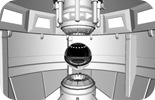 Breakpoint 2009 has seen a lot of first-time productions by new demo groups; of these my favorite is PC-03 ON/OFF by Panda Cube. A stylized 3D flyby with subtle shades and nice presentation. I hope these guys go on to make demos, lots of potential there!
Breakpoint 2009 has seen a lot of first-time productions by new demo groups; of these my favorite is PC-03 ON/OFF by Panda Cube. A stylized 3D flyby with subtle shades and nice presentation. I hope these guys go on to make demos, lots of potential there!
 Although this was not strictly their first production, Conscious of Blue by System-K is another favorite of mine: a clean, well-designed and imaginative demo that’s very different from the typical European demo style. No surprises there; these guys come from Japan. I didn’t even know Japan had an active demoscene, although for the life of me I don’t see why not. Kudos guys!
Although this was not strictly their first production, Conscious of Blue by System-K is another favorite of mine: a clean, well-designed and imaginative demo that’s very different from the typical European demo style. No surprises there; these guys come from Japan. I didn’t even know Japan had an active demoscene, although for the life of me I don’t see why not. Kudos guys!
 While Crush by Anadune and Floppy was not the only enjoyable PC demo at Breakpoint 2009, it was certainly the most impressive: the right blend of technology, design and music. Borrowing a leaf from Debris by farbrausch, this demo features plenty of deformable objects and lots of glow, but is different enough in style, pacing and content to stand out on its own. Two or three scenes here (such as the one pictured) are simply astounding.
While Crush by Anadune and Floppy was not the only enjoyable PC demo at Breakpoint 2009, it was certainly the most impressive: the right blend of technology, design and music. Borrowing a leaf from Debris by farbrausch, this demo features plenty of deformable objects and lots of glow, but is different enough in style, pacing and content to stand out on its own. Two or three scenes here (such as the one pictured) are simply astounding.
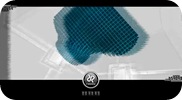 It seems white is the new black, with at least three white-themed productions at this party alone. With that in mind, 060659 by Rebels is an excellent (if not groundbreaking), stylized 64k intro that’s always great to watch. The commodore fan-service in the middle is gratuitous, although the effect itself is absolutely brilliant. Music is also subpar, but the design more than makes up for it IMO.
It seems white is the new black, with at least three white-themed productions at this party alone. With that in mind, 060659 by Rebels is an excellent (if not groundbreaking), stylized 64k intro that’s always great to watch. The commodore fan-service in the middle is gratuitous, although the effect itself is absolutely brilliant. Music is also subpar, but the design more than makes up for it IMO.
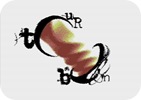
One of the most technically impressive C64 demo I’ve ever seen (possibly on par with Second Reality 64), Das Gotler by Extend and Dekadence hits you from the very first moment (with how the C64 basic window is cleared). The downside? Horrible, horrible music.
 The last few years have seen some amazing new artistic outlets for the scene, particularly commercial-quality animations in the compos. Breakpoint 2009 had a couple of fantastic entries, notably the winning duo. 2nd place animation compo winner Julie by Nuance is both a fantastic artistic expression and a terrific tech demo: with a 300 Euro budget and stuff they had lying around at home, the team tried (rather successfully) to imitate the bullet-time effect popularized by The Matrix. They’ve also released a “making of” document that’s a fairly interesting read.
The last few years have seen some amazing new artistic outlets for the scene, particularly commercial-quality animations in the compos. Breakpoint 2009 had a couple of fantastic entries, notably the winning duo. 2nd place animation compo winner Julie by Nuance is both a fantastic artistic expression and a terrific tech demo: with a 300 Euro budget and stuff they had lying around at home, the team tried (rather successfully) to imitate the bullet-time effect popularized by The Matrix. They’ve also released a “making of” document that’s a fairly interesting read.
 On the other end of the spectrum you’ll find JCO’s Spiechergurke, a fake commercial for a new kind of storage product (watch with subtitles). Other than being very well made it made me laugh my ass off. I think all in all Julie was the better production, but it was a very hard toss-up between the two; at any rate I’m glad both won the competition (Speichergurke took 1st place).
On the other end of the spectrum you’ll find JCO’s Spiechergurke, a fake commercial for a new kind of storage product (watch with subtitles). Other than being very well made it made me laugh my ass off. I think all in all Julie was the better production, but it was a very hard toss-up between the two; at any rate I’m glad both won the competition (Speichergurke took 1st place).

Jesus Christ Motocross by Nature and Traktor is, other than being a heavy hitting, funny and fun to watch, an amazingly impressive Amiga demo. Nontrivial effects (all in software, obviously), psychotic pacing and music and apparently artifact-free code are all fine and dandy, but the Tron tribute pictured on the right won my heart.

That said, Lightshaft by Elude is a very strong runner-up; 2nd place Amiga demo compo winner, this demo combines an incredibly impressive array of 3D scenes with epic design and pacing, terrific graphics and excellent music. It’s ironic that the two winning Amiga demos were so impressive whereas the PC demo compo suffered from general lack of enthusiasm and polish.
 Easily the best PC 4k intro I have ever seen, Elevated by Rgba and TBC is also possibly the first to ever get me excited. Astounding visuals, top notch design and excellent music are only part of it; the picture on the right really does not do this production justice, and you should definitely watch it in its entirety at least once to appreciate just how amazingly good a demo can be at 4096 bytes!
Easily the best PC 4k intro I have ever seen, Elevated by Rgba and TBC is also possibly the first to ever get me excited. Astounding visuals, top notch design and excellent music are only part of it; the picture on the right really does not do this production justice, and you should definitely watch it in its entirety at least once to appreciate just how amazingly good a demo can be at 4096 bytes!
Other notable productions from Breakpoint 2009:
- Defcon Zero by Scarab for the Nintendo DS
- Syntax Infinity by Tulou and Traktor for the MSX2 platform
- fr-065: euphotic by farbrausch, a technically impressive but boring and uninspired PC demo
- Enigma Sequence by Approximate, a 64k intro that’s really close to being awesome. I think a couple more weeks of polish would’ve really turned this one into a winner, but as is it’s quite raw.
- Luminagia by Loonies, Amiga 4k intro. Not quite as polished as the PC 4ks of the last few years, but damned impressive never-the-less.
I also got to watch the following productions on the big screen at Breakpoint, each of which is a recommended watch:
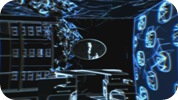 While Breakpoint was still in progress, Rupture by Andromeda Software Development won 1st place in the demo party at The Gathering 2009 and with all due reason: this demo is fantastic. Coherent design, astounding visuals, excellent pacing and music – it does everything well. For a demoscene fan, watching this on the big screen was a little like watching Terminator 2 in the theater for the first time: it gives you a profound sense of “this is what production values are all about.” The screenshot can’t do it justice, just go watch it already!
While Breakpoint was still in progress, Rupture by Andromeda Software Development won 1st place in the demo party at The Gathering 2009 and with all due reason: this demo is fantastic. Coherent design, astounding visuals, excellent pacing and music – it does everything well. For a demoscene fan, watching this on the big screen was a little like watching Terminator 2 in the theater for the first time: it gives you a profound sense of “this is what production values are all about.” The screenshot can’t do it justice, just go watch it already!
 Conversely, NVScene 2008 winner Stargazer by Andromeda and Orb is not as fluently directed but at least as technically impressive. I simply love Andromeda’s flow, the way they always manage to bring closure to a scene before moving on to the next effect, even if the two aren’t related in any way. Stargazer is a slideshow of some of the most impressive effects ever seen in a demo, with astonishing visuals and excellent techno music; I’m not sure which of the two (Stargazer or Rupture) I like better, but I guess they each appeal to a different school. Both are definitely must-see.
Conversely, NVScene 2008 winner Stargazer by Andromeda and Orb is not as fluently directed but at least as technically impressive. I simply love Andromeda’s flow, the way they always manage to bring closure to a scene before moving on to the next effect, even if the two aren’t related in any way. Stargazer is a slideshow of some of the most impressive effects ever seen in a demo, with astonishing visuals and excellent techno music; I’m not sure which of the two (Stargazer or Rupture) I like better, but I guess they each appeal to a different school. Both are definitely must-see.
 A veritable demoscene poster-boy, the NVScene 2008 invitation intro Masagin is the brainchild of Paniq (the guy behind Die Ewigkeit Schmerzt). A high quality production with an obvious artistic bent, Masagin blends excellent music with unique effects and fluid design and is one of the most engaging demos I’ve seen in years.
A veritable demoscene poster-boy, the NVScene 2008 invitation intro Masagin is the brainchild of Paniq (the guy behind Die Ewigkeit Schmerzt). A high quality production with an obvious artistic bent, Masagin blends excellent music with unique effects and fluid design and is one of the most engaging demos I’ve seen in years.
 Andromeda Software Development demos typically fall into one of two categories: artistically done 3D slideshows (Dreamchild, Rupture), and technically impressive video art (Evolution of Vision, Beyond the walls of Eryx). Midnight Run, 3rd place winner at NVScene 2008, is definitely of the latter sort, seamlessly blending 2D and 3D graphics with a bizarre screenplay and excellent music. Although not trivial by any means, if you’re looking for a technical demo to boggle your friends’ minds with, look elsewhere; Midnight Run is definitely for those not looking at demos with just an analytic eye.
Andromeda Software Development demos typically fall into one of two categories: artistically done 3D slideshows (Dreamchild, Rupture), and technically impressive video art (Evolution of Vision, Beyond the walls of Eryx). Midnight Run, 3rd place winner at NVScene 2008, is definitely of the latter sort, seamlessly blending 2D and 3D graphics with a bizarre screenplay and excellent music. Although not trivial by any means, if you’re looking for a technical demo to boggle your friends’ minds with, look elsewhere; Midnight Run is definitely for those not looking at demos with just an analytic eye.
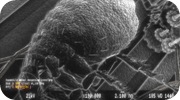 Proving my previous point, Euskal 2008 demo compo winner Size Antimatters by Andromeda Software Development is precisely the opposite of Mindight Run: it’s a technological powerhouse with amazing effects and great techno music, a lot faster paced than Midnight Run and built for a different audience. Along with Rupture and Stargazer, these are my current “show off your rig” demos. Kudos!
Proving my previous point, Euskal 2008 demo compo winner Size Antimatters by Andromeda Software Development is precisely the opposite of Mindight Run: it’s a technological powerhouse with amazing effects and great techno music, a lot faster paced than Midnight Run and built for a different audience. Along with Rupture and Stargazer, these are my current “show off your rig” demos. Kudos!
 ½-bit Cheese are fast becoming my favorite demoscene animators. Their Assembly 2008 wild compo tour de force Field Trip features some of the most amazing animation, visual effects, music and direction I’ve ever seen, taking the already-excellent talents of Maxson and D-Fast (of Realtime Demo Wannabe fame) to the next level. Groundbreaking!
½-bit Cheese are fast becoming my favorite demoscene animators. Their Assembly 2008 wild compo tour de force Field Trip features some of the most amazing animation, visual effects, music and direction I’ve ever seen, taking the already-excellent talents of Maxson and D-Fast (of Realtime Demo Wannabe fame) to the next level. Groundbreaking!